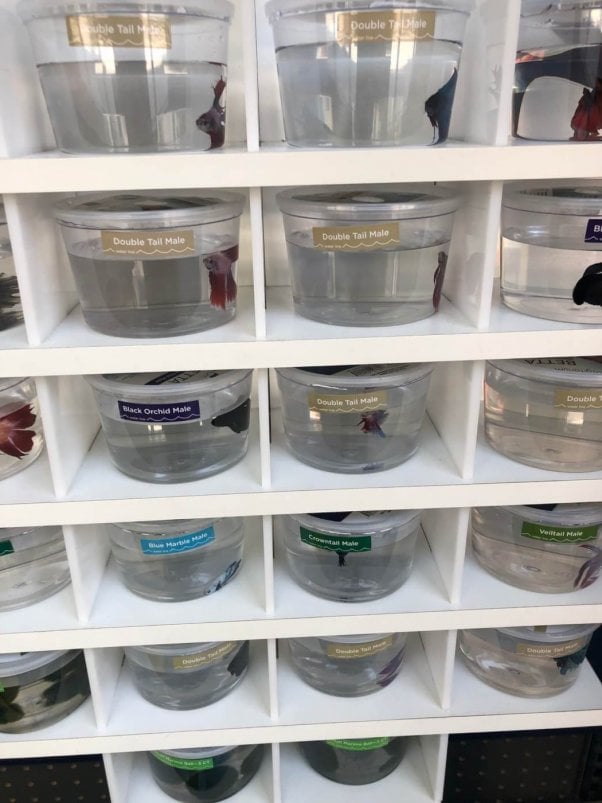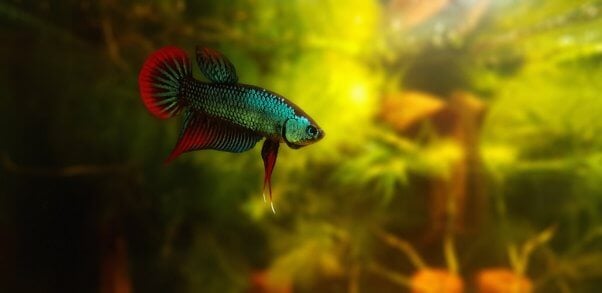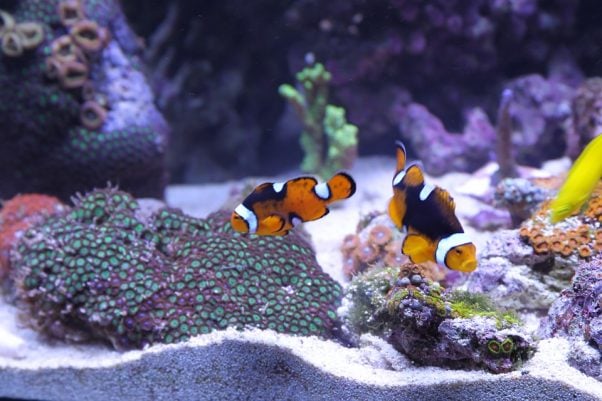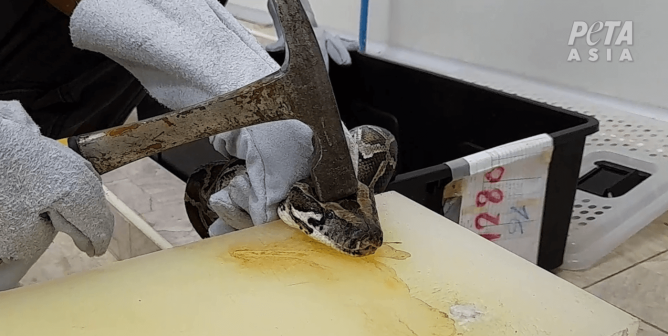Is It Cruel to Keep Fish in Tanks? Here Are the Startling Facts
Fish are intelligent, sensitive animals who think and feel pain the same way that cats and dogs do. Scientists at Oxford University have discovered that some fish can learn faster than dogs. Fish crave stimulation from other fish and from their environment. They are adapted to dwell in the majestic seas—even the biggest, best-maintained aquarium can’t compare to nature.
Fish are often treated as mere merchandise. Each year, millions of them are purchased as decorative ornaments or “starter pets” for young children. Few people realize just how much fish suffer before they reach pet stores or know how to care for them properly once they get them home.
Approximately 95% of the saltwater fish sold in pet shops are taken from their natural homes, mostly from the waters around Fiji, Indonesia, the Philippines, and other Pacific islands. Divers often squirt cyanide or other poisons into the coral reefs where fish live. They use cyanide to stun fish so that they will drift out of a reef for easy collection. It also sends many fish into spasms, making them easy to grab by hand or net. Marine experts estimate that half the affected fish die on the reef and that 40% of those who survive the initial poisoning die before they reach an aquarium.
About 90% of the freshwater fish sold in stores are raised on fish farms. Goldfish, for example, are usually bred and raised in giant tubs on farms that raise as many as 250 million fish a year. Many of them are doomed to live in plastic bags or tiny glass bowls, neither of which provides the space or oxygen that goldfish need. For this reason, the city of Monza, Italy, banned keeping goldfish in bowls. One sponsor of the law pointed out that bowls give fish “a distorted view of reality.”
Fish are living, feeling beings, not artwork, yet some fish breeders inject fluorescent dye into their bodies or alter their genetic makeup to make them more attractive to buyers. Pet shops, discount superstores, florists, and even online catalogs sell “decorative” betta fish (or Siamese fighting fish) in tiny cups or flower vases. The fish often live in just a few ounces of water, which isn’t enough to turn around in, much less swim in.
When you purchase fish or support businesses or fairs that give fish away in contests or promotions, it encourages the pet trade to continue kidnapping fish from their ocean home and breeding them on crowded, filthy farms. If you enjoy watching fish, consider downloading one of the many colorful and realistic fish-themed computer screensavers available on the web.
As Gill, one of the characters in Finding Nemo—a charming movie about a clownfish who struggles to escape from an aquarium and find his way back to his father in the ocean—says, “Fish aren’t meant to be in a box, kid. It does things to ya.”
But don’t despair if you already have fish. Although there’s no safe way to return captive fish to their natural habitats—which are often located in distant regions of the world—partly because of the possibility of introducing disease to wild fish populations, the following are some ways that you can make your fish friends happier:
- Provide a stable environment. Place a tank on a smooth surface that won’t rock or jiggle, keep it away from direct sunlight, and avoid temperature extremes. It’s also important to keep the fish away from other animal companions, such as cats, who may take an interest in them. Purchasing a lid for the top of your tank is a great idea for keeping other animals away from your fish, as well as blocking any debris that may be in the air.
- Make sure that fish get proper nutrients. That jar of flakes might not be what your fish would choose to eat. The right type and amount of food varies from fish to fish, so take the time to learn what your fish need.
- Learn about the space requirement needed for your fish. Betta fish require at least 5 gallons of tank space to swim in comfortably and at least 10 gallons to thrive. Goldfish need at least 75 gallons to swim comfortably. In addition, different species of fish have particular dispositions and may or may not prefer to be housed with other fish, depending on their needs and unique personalities. Male bettas cannot be housed with other male bettas. Research what your fish need in terms of space and their social needs, and make sure you can provide it.
- House fish in a large filtered tank. All tanks should have a pump to keep water flowing continuously. Depending on the species of fish, your companions may prefer more or less water movement. Where would your fish companion reside in nature? What would the movement of the water be like there? Bettas, for example, prefer minimal water movement. While it’s crucial to have a filter in your tank, be sure to find one that moves water at a speed comparable to what your fish are accustomed to in their natural habitat.
- Decorate! Bare homes make for frustrated fish. Place structures in a tank for your fish to investigate. Some fish will use tank-lining rock bits to build nests for themselves. A few plants will make your fish feel more at home. Plastic plants are OK, but real plants are best because they make a tank more like a natural habitat. A routine water change provides an excellent opportunity to redecorate your companion’s home. Experiment with the placement of decorations and structures with every water change so that your fish can explore different configurations.
- Keep them in a quiet area. Fish “talk” with one another through a range of low-frequency sounds. The pumps and filters necessary in many home aquariums can interfere with this communication, so use quiet equipment and don’t place radios or televisions near your fish.
- Never support stores that sell fish. If you’re looking to welcome fish companions into your family in an ethical manner, you can explore a few options. Be sure to check Petfinder or local animal shelters and rescues for fish in need of a loving home. You can also find fish-care supplies secondhand from community groups. Never buy animals from pet stores or anywhere else.
- Keep your tank clean. Nobody wants to live in a dirty home. Living in dirty conditions makes fish susceptible to diseases such as fin and tail rot. You should keep your tank clean by using a filter, changing the water regularly (yes, even with a filter, you must do this), and using a gravel vacuum to suck up dirt and other debris at the bottom of your tank that’s lodged under rocks and decorations. You can also purchase select aquatic plants that can help filter the water, such as marimo moss for freshwater tanks. How often your tank should be cleaned depends on its size and the number of inhabitants.
- Treat your water. Whether you’re caring for a freshwater fish or a saltwater fish, tap water from the sink simply won’t do. At a minimum, it’s necessary to treat water with water conditioner. It’s best to treat water further with stabilizer to avoid “new tank syndrome” when introducing your new companions to their home. It can be fatal if you’re not careful.
- Learn about what your fish needs in terms of temperature. Fish kept in tanks that are too hot or too cold for their bodies are more susceptible to illness and death than others. For example, betta fish are native to tropical areas, and water temperatures between 75 and 80 degrees are most comfortable for them. Get a tank thermometer, and if your environment is too chilly for your fish, get a water heater, too.
- Be prepared to care for your fish in all circumstances. Maybe your fish have become ill and you need to provide treatment for them, or maybe you’re planning to travel and you won’t be able to feed your fish while you’re away. Your animal companions have no control over these things, so it’s your responsibility as their caretaker to maintain their well-being. You should learn about the illnesses your fish could endure, how to recognize them, how to avoid them, and how to treat them. Be available for your animal companions in sickness and in health, and understand that they’re counting on you to help with their basic needs.
- Follow groups and organizations on social media that can help you learn continually about fish. Fish sanctuaries across the U.S., including Friends of Philip, take in animals who were surrendered or abused by pet stores. In addition to doing vital work for fish, they often share information that can be helpful for you to know.
- Speak up for fish. If you see someone who’s treating fish like decorations or otherwise neglecting their fish companions, speak up! If their fish could say something, they would.
Fish rely on their caretakers to spot types of behavior and other signs indicating that they’re unhappy, unhealthy, or both. It’s your responsibility to monitor your companions closely in order to ensure that their environment is suitable for them and that they’re getting the enrichment they need to thrive.
To make sure that you’re providing the best possible care for your fish friends, please read PETA’s other helpful tips on caring for fish.










